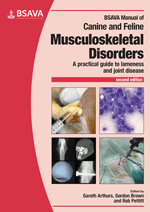
Full text loading...

This chapter addresses a variety of metabolic bone diseases and some otherwise poorly categorized bone disorders such as bone cysts and infarcts. Metabolic bone diseases affect all parts of the skeleton to different degrees and all can cause lameness. This chapter covers common hyperostotic and osteopenic conditions.
Diseases and disorders of bone, Page 1 of 1
< Previous page | Next page > /docserver/preview/fulltext/10.22233/9781910443286/9781910443286.7-1.gif

Full text loading...




















